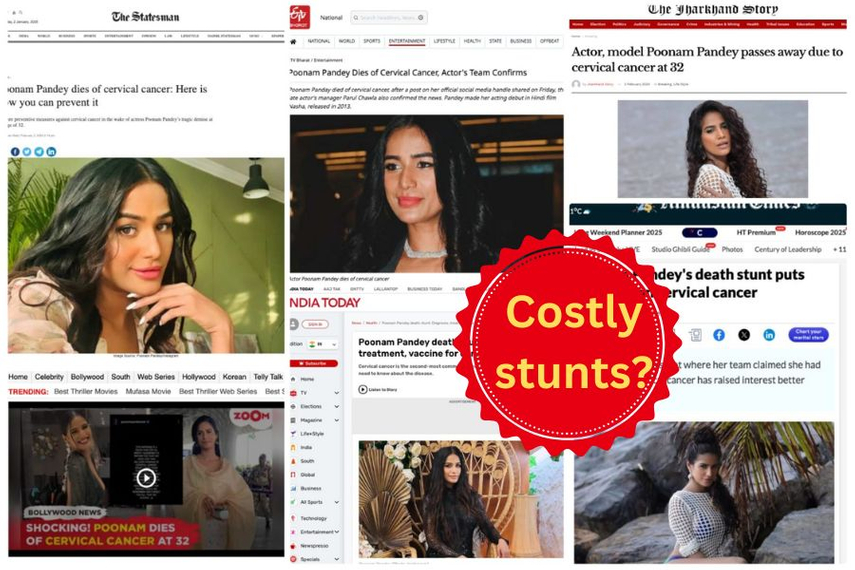
Grabbing eyeballs is becoming more challenging than ever in the swipe-up landscape. Last year, two major instances spotlighted a trend of negative marketing. In one incident, an Indian beauty service startup, Yes Madam fired its employees for giving honest feedback about job-related stress. But later came a clarification from the company that no one was fired and that it was just a stunt.
In another incident, the manager of Bollywood actress Poonam Pandey announced her death due to cervical cancer only to reveal a couple of days later that she was perfectly healthy and that the stunt was intended to raise cervical cancer awareness.
In both cases, the brands were trolled extensively on social media for their tone-deaf marketing stunts.
In an era where consumer perception can make or break a brand overnight, understanding the balance between provocation and responsibility has never been more critical. While these campaigns achieved their primary goal of grabbing headlines, they also sparked widespread debate about the fine line between clever publicity and risk of damage to brand reputation.
Negative marketing, by design, courts controversy to amplify visibility—but at what cost? For some, the attention it garners outweighs the backlash; for others, it raises ethical concerns and potential, long-term damage to brand trust.
These incidents prompt an important question: is negative marketing a calculated risk worth taking, or does it signal a lack of creativity and sensitivity? Campaign speaks to industry experts to unpack the ethics and risks involved in and effectiveness of negative marketing tactics in shaping brand narratives.
Sahaan Suman K, founder, Bubble Network:

Brands often turn to negative marketing to generate buzz and quickly capture public attention, especially when competing for visibility in crowded markets. These tactics, even if controversial, can generate publicity and social media chatter. However, such tactics come with risks, including damaging the brand’s reputation, alienating loyal customers, or facing backlash for being insensitive or exploitative.
While negative marketing may offer short-term visibility, its sustainability is questionable. It risks creating an antagonistic brand image that may turn consumers away in the long run. Ethical concerns arise when campaigns appear to prioritise shock value over meaningful social causes or when they exploit sensitive topics. Brands that rely on controversy may fail to build trust and long-term loyalty, essential for sustainable growth.
To balance the need for attention with maintaining brand integrity, companies should aim for campaigns that spark conversation without alienating key audiences. Consumers and critics can differentiate between genuine efforts and publicity stunts by considering the context, messaging, and consistency of a brand’s actions.
If a campaign seems to exploit a cause without contributing meaningfully, it is likely a publicity stunt. This blurred line complicates how brands are perceived, and those that cross it risk losing credibility.
Udit Yadav, founder and director, Satan Digital:

Brands may use negative marketing to quickly grab attention and stand out, but that can harm their trustworthiness and brand value in the long run. Such tactics often seem unethical and can alienate customers. It is better for brands to focus on honest, reliable marketing that builds genuine relationships with consumers.
Negative marketing can hurt a brand’s reputation over time. While it might grab attention at first, it damages trust and relationships with customers, making it unsustainable. Positive marketing, on the other hand, builds lasting connections and is a better long-term strategy.
Every brand can balance buzz and attention by staying authentic, knowing their audience, and being sensitive to different perspectives. It’s really important to focus on inclusivity, avoid controversial topics, and ensure messaging aligns with core values to prevent alienating potential customers.
Consumers and critics can tell the difference by evaluating the authenticity of a brand’s message. Genuine attempts engage in thoughtful and relevant discussions, while publicity stunts feel shallow and short-lived. Consumers value transparency and authenticity over gimmicks for lasting trust.
Ajay Kulkarni, business head, Ykone Barcode:

In a world where Instagram reels and 140-character tweets dominate, in-search of dopamine, both consumers and brands often resort to sensationalism to cut through the noise. Brands are under pressure to deliver instant impact. However, the risks—loss of trust, brand boycotts, and long-term reputation damage—can outweigh the short-term gains.
Negative marketing is rarely sustainable. Brands like Amul have shown that consistent storytelling rooted in humour and social commentary can build loyalty over decades. In contrast, shock value campaigns like PETA’s polarising milk ads may grab headlines but struggle to create enduring connections with audiences.
The key is empathy and purpose. Ariel’s ‘Share the Load’ campaign is a masterclass in addressing societal issues while staying true to its brand ethos. Similarly, Tata Tea’s ‘Jaago Re’ balances bold messaging with cultural sensitivity. Brands must ensure their campaigns respect the diversity and emotional nuances of the Indian audience.
In marketing, staying authentic and committed to purpose, even amidst challenges, is what builds lasting legacies. Quick wins fade. As marketers, we must remember that while buzz fades, trust is built over time. Brands that invest in authenticity and purpose create legacies—not just headlines.
Aman Gupta, managing partner, SPAG FINN Partners:

Negative marketing often arises from a brand’s desire to cut through the noise in a competitive environment. However, the risks include losing trust, pushing away audiences, and creating a perception of insensitivity, which can significantly harm long-term brand reputation. While immediate attention might seem attractive, such tactics rarely lead to sustainable growth or meaningful consumer relationships.
Marketing should balance creativity with responsibility. Negative tactics often rely on shock value, which may alienate certain audience segments or strain relationships with stakeholders. Instead, brands should focus on purposeful storytelling and authentic engagement that build credibility and trust over time.
Determining the intent behind a campaign is critical. A genuine effort to spark dialogue around social issues can create a lasting positive impact, but publicity stunts designed solely to grab attention often lack substance and can undermine the brand’s integrity. Customers today are thoughtful and value honesty. For brands, this means creating campaigns that reflect their core values while connecting with different audiences.
Effective marketing generates buzz without compromising ethics. By embracing strategic, integrated approaches, brands can achieve visibility and relevance while fostering meaningful connections with their audiences.
Abhishek Razdan, co-founder and chief executive officer, Avtr Meta Labs:

Brands often resort to negative marketing tactics because they can generate immediate buzz and virality. In today’s attention economy, controversial or provocative campaigns are a shortcut to grabbing eyeballs, especially in a cluttered digital space. Negative marketing is rarely a sustainable or ethical strategy. While it might deliver quick wins in terms of visibility, it often undermines a brand’s long-term credibility. Ethical concerns arise when campaigns exploit sensitive issues or mislead audiences, eroding trust and goodwill.
Sustainability in marketing comes from authenticity, positive engagement, and adding value to consumers’ lives. Negative tactics might work temporarily but leave lasting scars on the brand-consumer relationship, making them a poor choice for brands looking to build enduring loyalty.
Genuine and meaningful campaigns are upfront about their purpose and connect to a brand’s values or mission. They inspire dialogues and actions. Publicity stunts often lack substance or follow-through and typically fade after the initial buzz.
The blurred line challenges brands to be more accountable. Consumers are increasingly critical of inauthenticity, and marketers must prioritise transparency and long-term trust over fleeting attention.



.jpg&h=268&w=401&q=100&v=20250320&c=1)
.jpg&h=268&w=401&q=100&v=20250320&c=1)

.png&h=268&w=401&q=100&v=20250320&c=1)



